 W
WAiptasia mutabilis, also known as the trumpet anemone, rock anemone, and glass anemone, is a species of anemone typically found attached to substrates in cold waters of the Atlantic Ocean. Its unique trumpet shape gives it its common name and it can grow to be 12 cm, having a column between 3 and 6 cm in size. Like many cnidarians, they rely on nematocysts for protection and to capture prey. They are not difficult to care for, and can be kept in a home aquarium, although due to their speed of reproduction, can quickly become overpopulated.
 W
WAlcyonium coralloides, commonly known as false coral, is a colonial species of soft coral in the family Alcyoniidae. It is native to the northeastern Atlantic Ocean and the Mediterranean Sea. In the former location it generally grows as sheets or small lobes but in the latter it is parasitic and overgrows sea fans.
 W
WAlicia mirabilis, commonly known as the berried anemone, is a species of sea anemone in the family Aliciidae. It changes shape as night falls expanding its column and tentacles to catch its food. It can be found in the Azores, Portugal, Spain and the Mediterranean and Red Seas.
 W
WAnemonia sulcata, or Mediterranean snakelocks sea anemone, is a species of sea anemone in the family Actiniidae from the Mediterranean Sea. Whether A. sulcata should be recognized as a synonym of A. viridis remains a matter of dispute.
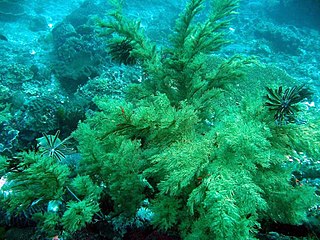 W
WAntipathes dichotoma is a species of colonial coral in the order Antipatharia, the black corals, so named because their calcareous skeletons are black. It was first described by the German zoologist and botanist Peter Simon Pallas in 1766, from a single specimen he received from near Marseilles in the Mediterranean Sea.
 W
WAplysina aerophoba is a species of sponge in the family Aplysinidae. It is a yellow, tube-forming or encrusting sponge and is native to the eastern Atlantic Ocean and the Mediterranean Sea; the type locality is the Adriatic Sea.
 W
WAplysina cavernicola is a species of sponge in the family Aplysinidae. It is native to the Mediterranean Sea where it grows in caves and under overhangs.
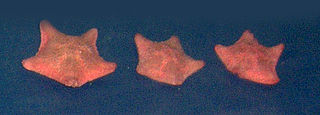 W
WAsterina gibbosa, commonly known as the starlet cushion star, is a species of starfish in the family Asterinidae. It is native to the northeastern Atlantic Ocean and the Mediterranean Sea.
 W
WAtrina fragilis, the fan mussel, is a species of large saltwater clam, a marine bivalve mollusc in the family Pinnidae, the pen shells.
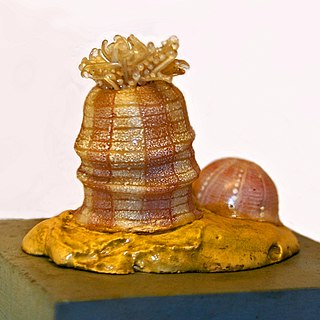 W
WAulactinia verrucosa, the gem anemone, is a species of sea anemone in the family Actiniidae. It is found on rocky coasts in the northeastern Atlantic Ocean, North Sea and Mediterranean Sea.
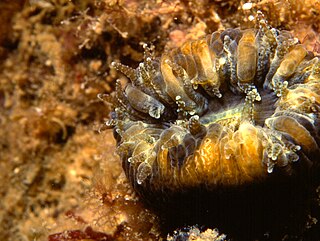 W
WBalanophyllia europea, called also scarlet coral or pig-tooth coral, is a small species of stony coral in the family Dendrophylliidae.
 W
WBodotria scorpioides is a species of crustacean belonging to the order Cumacea. They are found in the East Atlantic, the Mediterranean and the Black Sea. B. scorpioides does not possess a free telson. The first thoracic somite is too short to be seen from above, the second is longer. Both males and females have exopods on the first pereopods only.
 W
WCentrostephanus longispinus, the hatpin urchin, is a species of sea urchin in the family Diadematidae. There are two subspecies, Centrostephanus l. longispinus, found in the eastern Atlantic and Mediterranean Sea and Centrostephanus l. rubricingulus, found in the western Atlantic.
 W
WCereus pedunculatus or the daisy anemone is a species of sea anemone in the family Sagartiidae. It is found in shallow parts of the northeast Atlantic Ocean and in the North Sea and the Mediterranean Sea. It is an omnivore, predator and scavenger.
 W
WChelonibia testudinaria is a species of barnacle in the family Chelonibiidae. It is native to the Atlantic Ocean, Mediterranean Sea and Gulf of Mexico where it lives as a symbiont on sea turtles, being particularly abundant on the loggerhead sea turtle.
 W
WCliona viridis, commonly called the green boring sponge, is a species of demosponge in the family Clionaidae. Its form varies according to the nature of the surface on which it grows. In limestone and other calcareous substrates it excavates channels and chambers while on other types of rock it encrusts the surface or forms massive structures. It is native to the eastern Atlantic, the Mediterranean Sea and the Indo-Pacific Ocean.
 W
WCotylorhiza tuberculata is a species of jellyfish, of the phylum Cnidaria, also known as the Mediterranean jellyfish, Mediterranean jelly or fried egg jellyfish. It is commonly found in the Mediterranean Sea, Aegean Sea, and Adriatic Sea.
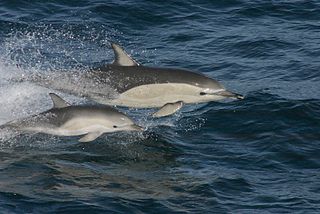 W
WThe short-beaked common dolphin is a species of common dolphin. It has a larger range than the long-beaked common dolphin, occurring throughout warm-temperate and tropical oceans, including the Indian Ocean although in smaller numbers than other places they are found. There are more short-beaked common dolphins than any other dolphin species in the warm-temperate portions of the Atlantic and Pacific Oceans. It is also found in the Caribbean and Mediterranean Seas. The short-beaked common dolphin is also abundant in the Black Sea, Gulf of Mexico, and Red Sea. They follow the gulf stream up to Norwegian waters. Seldom do any short-beaked dolphin venture near the Arctic.
 W
WThe Atlantic spotted dolphin is a dolphin found in the Gulf Stream of the North Atlantic Ocean. Older members of the species have a very distinctive spotted coloration all over their bodies.
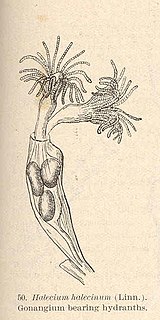 W
WHalecium halecinum, commonly known as the herring-bone hydroid, is a species of hydrozoan in the family Haleciidae. It is native to the eastern Atlantic Ocean, the western Atlantic Ocean and the eastern Pacific Ocean.
 W
WHolothuria forskali, the black sea cucumber or cotton-spinner, is a species of sea cucumber in the family Holothuriidae. It is found at shallow depths in the eastern Atlantic Ocean and the Mediterranean Sea. It was placed in the subgenus Panningothuria by Rowe in 1969 and is the typetaxon of the subgenus.
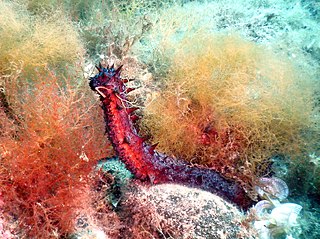 W
WHolothuria tubulosa, the cotton-spinner or tubular sea cucumber, is a species of sea cucumber in the family Holothuriidae. It is the type species of the genus Holothuria and is placed in the subgenus Holothuria, making its full name Holothuria (Holothuria) tubulosa.
 W
WIllex coindetii, commonly known as the southern shortfin squid or broadtail shortfin squid, is a species of neritic squids in the family Ommastrephidae. They are found in the Mediterranean Sea and on both sides of the north Atlantic Ocean.
 W
WThe seven-armed sea star is a species of sea star (starfish) in the family Luidiidae. It is found in the eastern Atlantic Ocean and the Mediterranean Sea.
 W
WMaasella is a genus of soft coral in the family Paralcyoniidae. It is monotypic, with only a single species, Maasella edwardsi. Usually of greenish brown or golden brown color, each polyp has eight pinnate tentacles. This soft coral is found in the Mediterranean Sea and the Atlantic Ocean, at depths of between 2 and 50 metres.
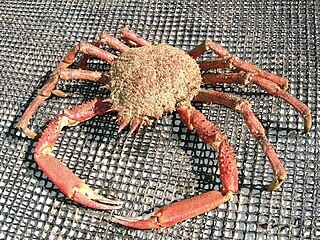 W
WMaja squinado is a species of migratory crab found in the north-east Atlantic and the Mediterranean Sea.
 W
WMarthasterias is a genus of starfish in the family Asteriidae. It is monotypic and the only species in the genus is Marthasterias glacialis, commonly known as the spiny starfish. It is native to the eastern Atlantic Ocean.
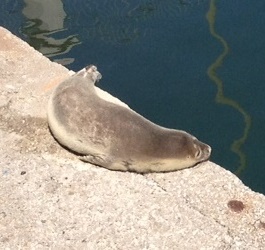 W
WThe Mediterranean monk seal is a monk seal belonging to the family Phocidae. As of 2015, it is estimated that fewer than 700 individuals survive in three or four isolated subpopulations in the Mediterranean, (especially) in the Aegean Sea, the archipelago of Madeira and the Cabo Blanco area in the northeastern Atlantic Ocean. It is believed to be the world's rarest pinniped species.
 W
WMesacmaea mitchellii is a species of sea anemone in the family Haloclavidae. It is found in the northeastern Atlantic Ocean and the Mediterranean Sea where it burrows in soft sediment.
 W
WMyxobolus spinacurvatura is a species of Myxozoa in the family Myxobolidae, that inhabits the Mediterranean Sea.
 W
WOchetostoma erythrogrammon is a species of spoon worm in the family Thalassematidae. It is found in shallow water in the Atlantic Ocean, the Mediterranean Sea, and the Indian and Pacific Oceans, burrowing in soft sediment.
 W
WOscarella lobularis is a species of sponge in the order Homosclerophorida. It is native to the northeastern Atlantic Ocean and the Mediterranean Sea, where it forms encrusting colonies on rocks and other hard surfaces.
 W
WParacentrotus lividus is a species of sea urchin in the family Parechinidae commonly known as the purple sea urchin. It is the type species of the genus and occurs in the Mediterranean Sea and eastern Atlantic Ocean.
 W
WParamuricea clavata, the violescent sea-whip, is a species of colonial soft coral in the family Plexauridae. It is found in shallow seas of the north-eastern Atlantic Ocean and the north-western Mediterranean Sea as well as Ionian Sea. This species was first described by the French naturalist Antoine Risso in 1826.
 W
WPawsonia saxicola, the sea gherkin, is a species of sea cucumber in the family Cucumariidae. It is found in the northeastern Atlantic Ocean and the Mediterranean Sea.
 W
WPhyllodoce lineata is a species of polychaete worm in the family Phyllodocidae. It is native to the northeastern Atlantic Ocean and the Mediterranean Sea where it occurs in the intertidal and shallow sub-tidal zones on soft sediment.
 W
WPontobdella muricata is a species of marine leech in the family Piscicolidae. It is a parasite of fishes and is native to the northeastern Atlantic Ocean, the Baltic Sea, the North Sea, and the Mediterranean Sea.
 W
WPorcellana platycheles, the broad-clawed porcelain crab, is a species of porcelain crab from the family Porcellanidae. It is found on the coasts of the eastern Atlantic Ocean and in the Mediterranean Sea
 W
WRhabdopleura normani is a small, marine species of worm-shaped animal known as a pterobranch. It is a sessile suspension feeder, lives in clear water, and secretes tubes on the ocean floor.
 W
WSagartia elegans, the elegant anemone, is a species of sea anemone in the family Sagartiidae. It is found in coastal areas of northwest Europe at depths down to 50 metres.
 W
WSagartia troglodytes is a species of sea anemone in the family Sagartiidae, also known as the mud sagartia or the cave-dwelling anemone.
 W
WSavalia savaglia, commonly known as gold coral, is a species of colonial false black coral in the family Parazoanthidae. It is native to the northeastern Atlantic Ocean and the Mediterranean Sea where it often grows in association with a gorgonian. It is extremely long-lived, with a lifespan of 2,700 years, and develops into a large tree-like colony.
 W
WThe snakelocks anemone is a sea anemone found in the eastern Atlantic Ocean and the Mediterranean Sea. The latter population is however sometimes considered a separate species, the Mediterranean snakelocks anemone.
 W
WThe sperm whale or cachalot is the largest of the toothed whales and the largest toothed predator. It is the only living member of the genus Physeter and one of three extant species in the sperm whale family, along with the pygmy sperm whale and dwarf sperm whale of the genus Kogia.
 W
WSphaerechinus granularis is a species of sea urchin in the family Toxopneustidae, commonly known as the purple sea urchin. Its range includes the Mediterranean Sea and eastern Atlantic Ocean.
 W
WSternaspis scutata is a species of marine polychaete worm in the family Sternaspidae. It occurs in the Mediterranean Sea and the temperate northeastern Atlantic Ocean. It lives submerged in mud or other soft sediment.